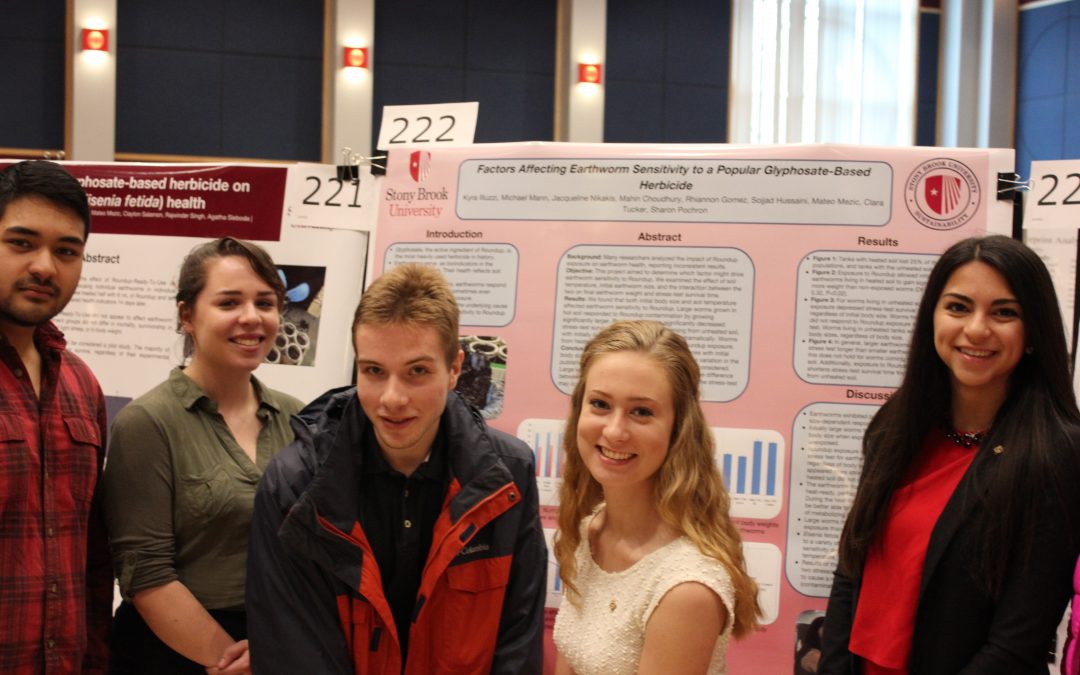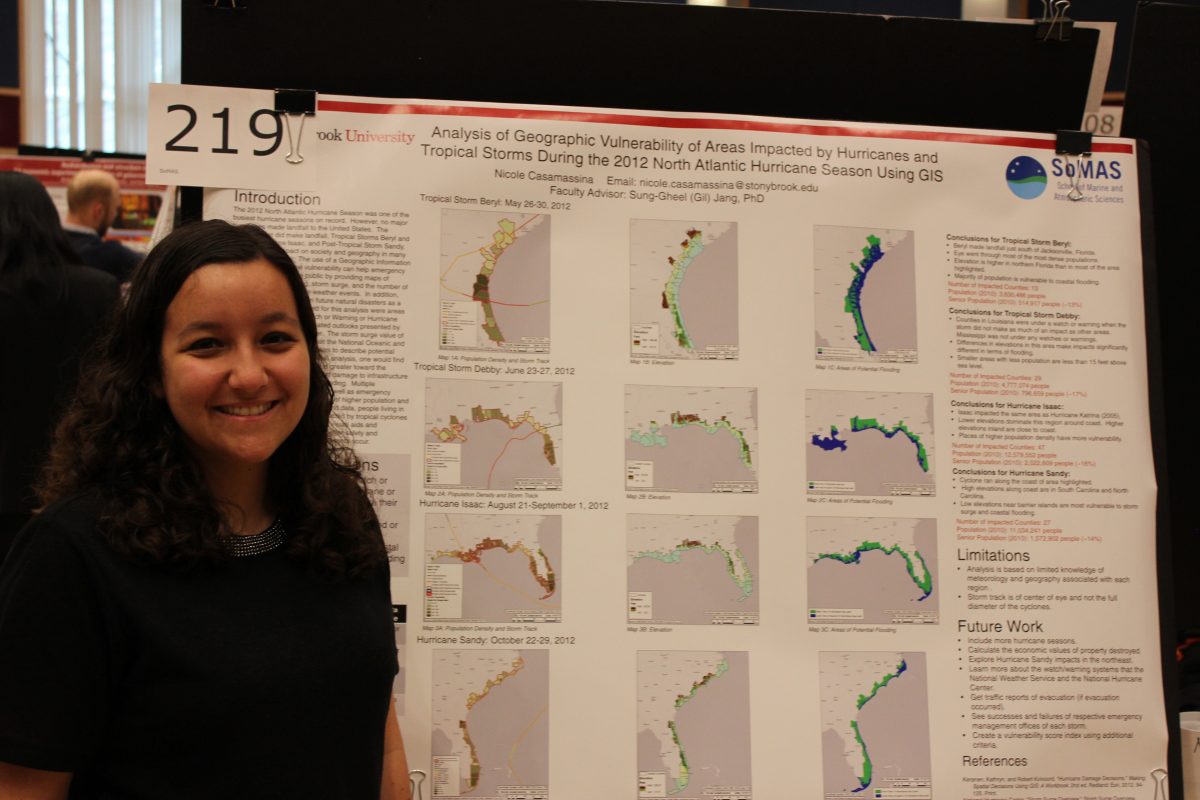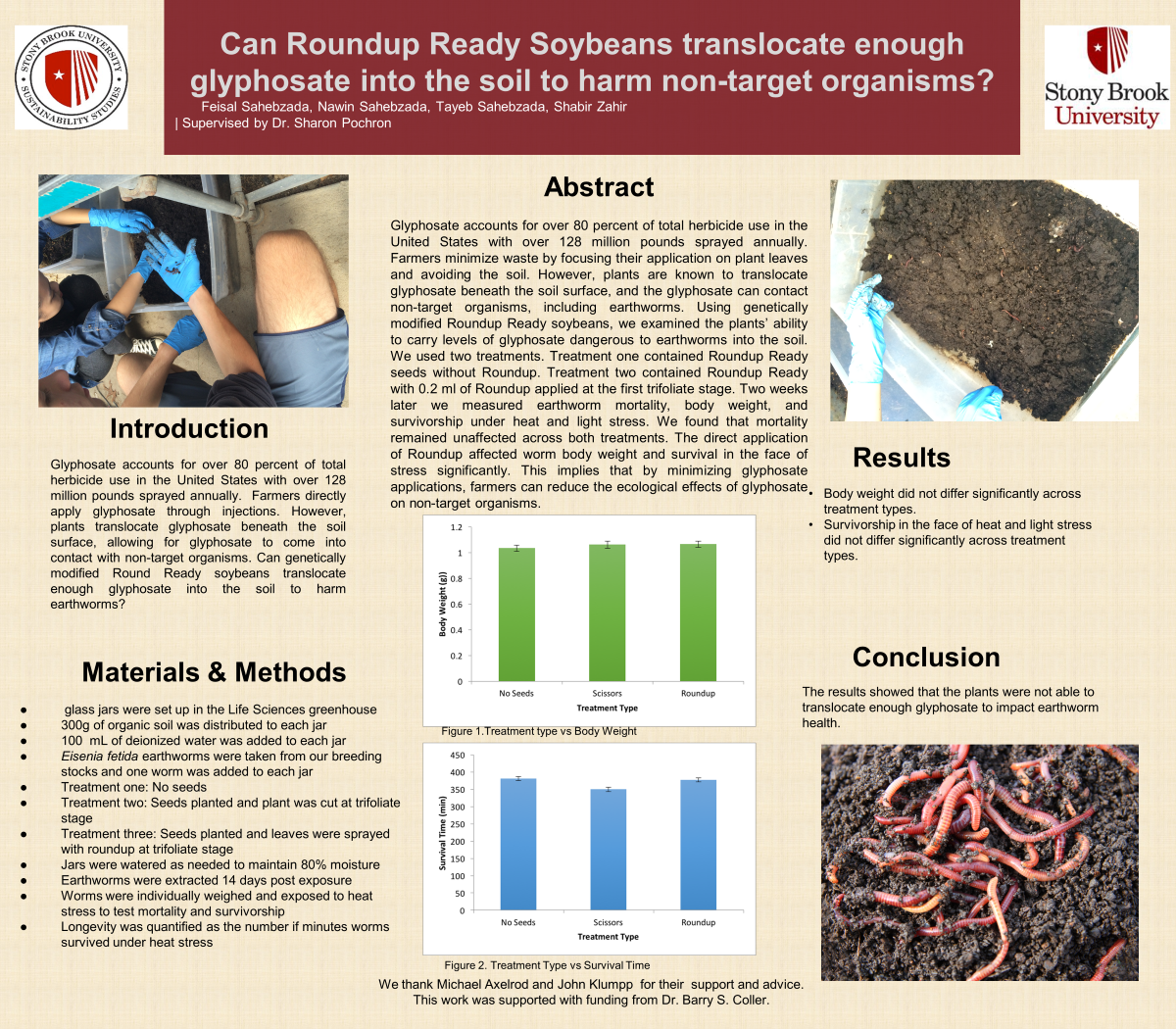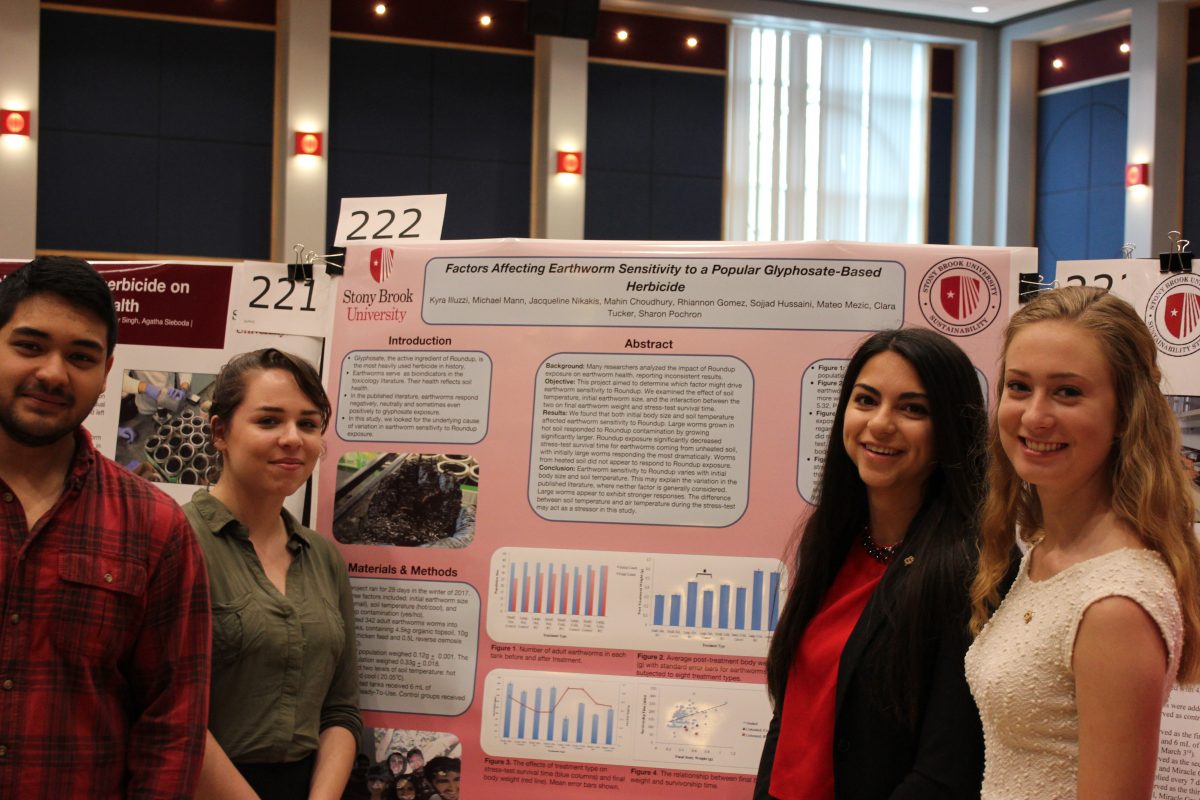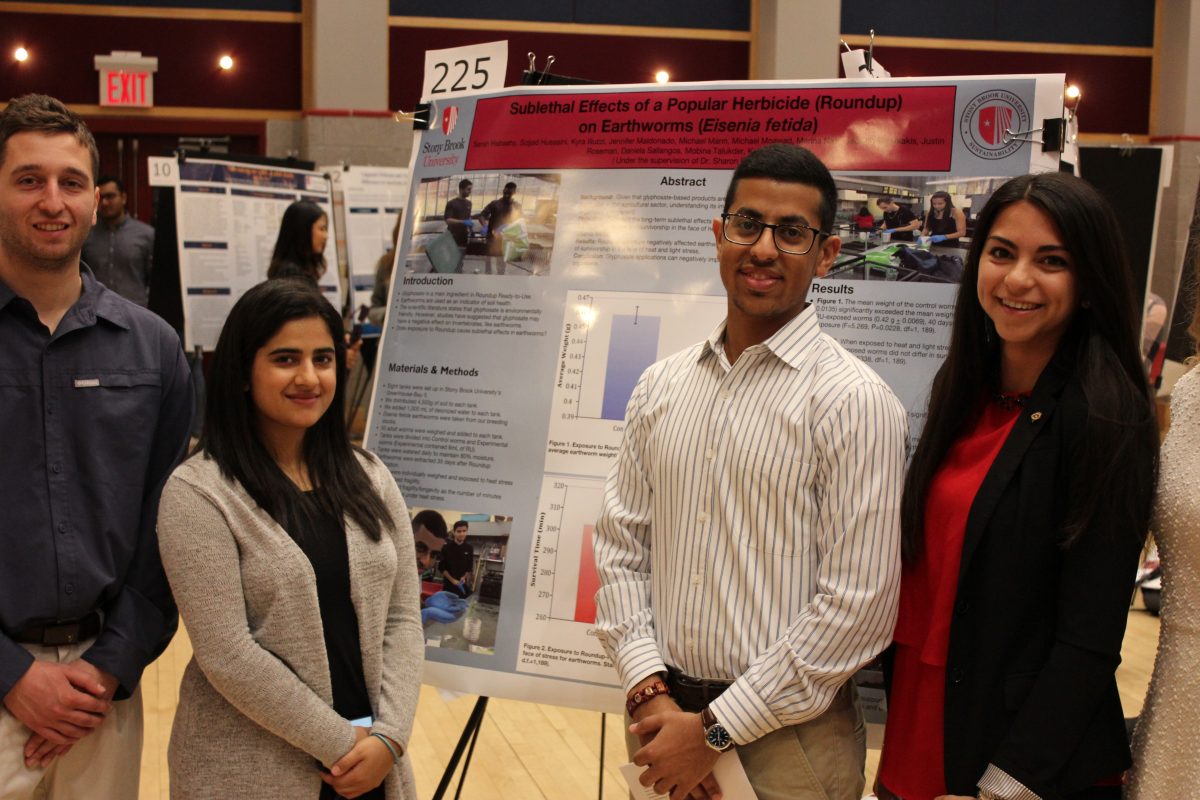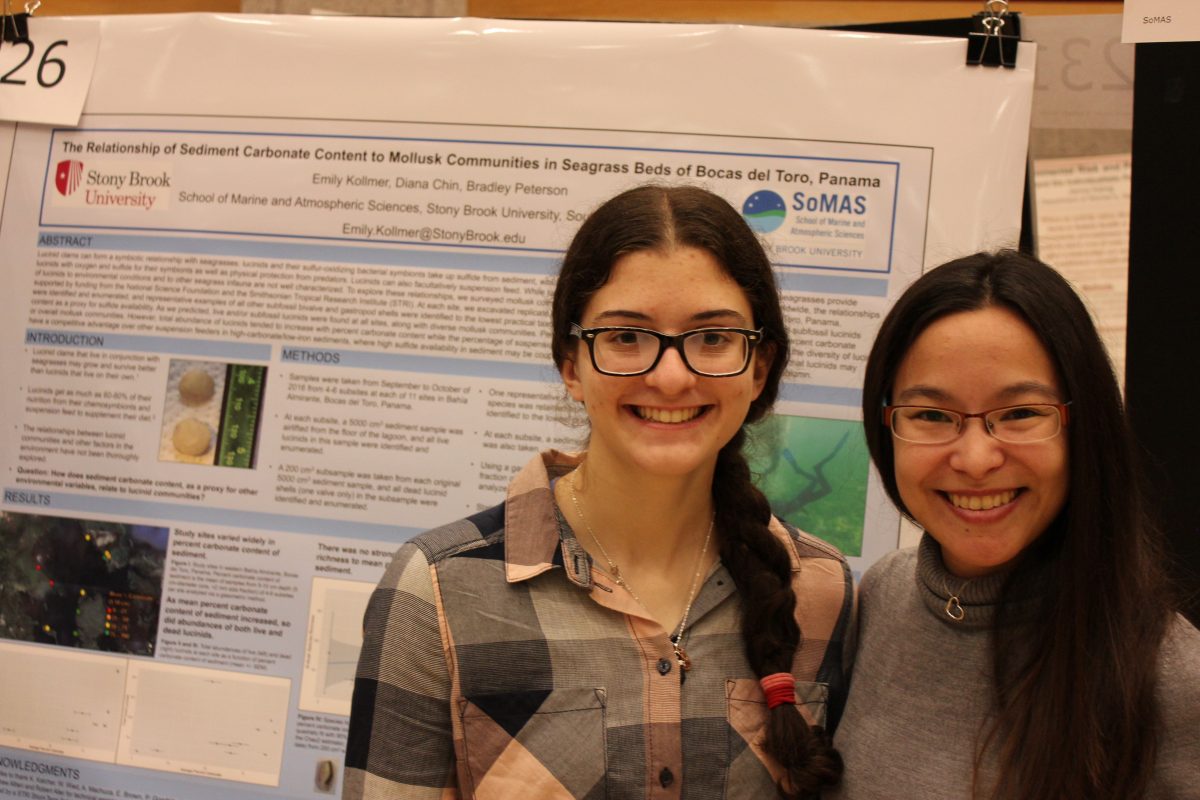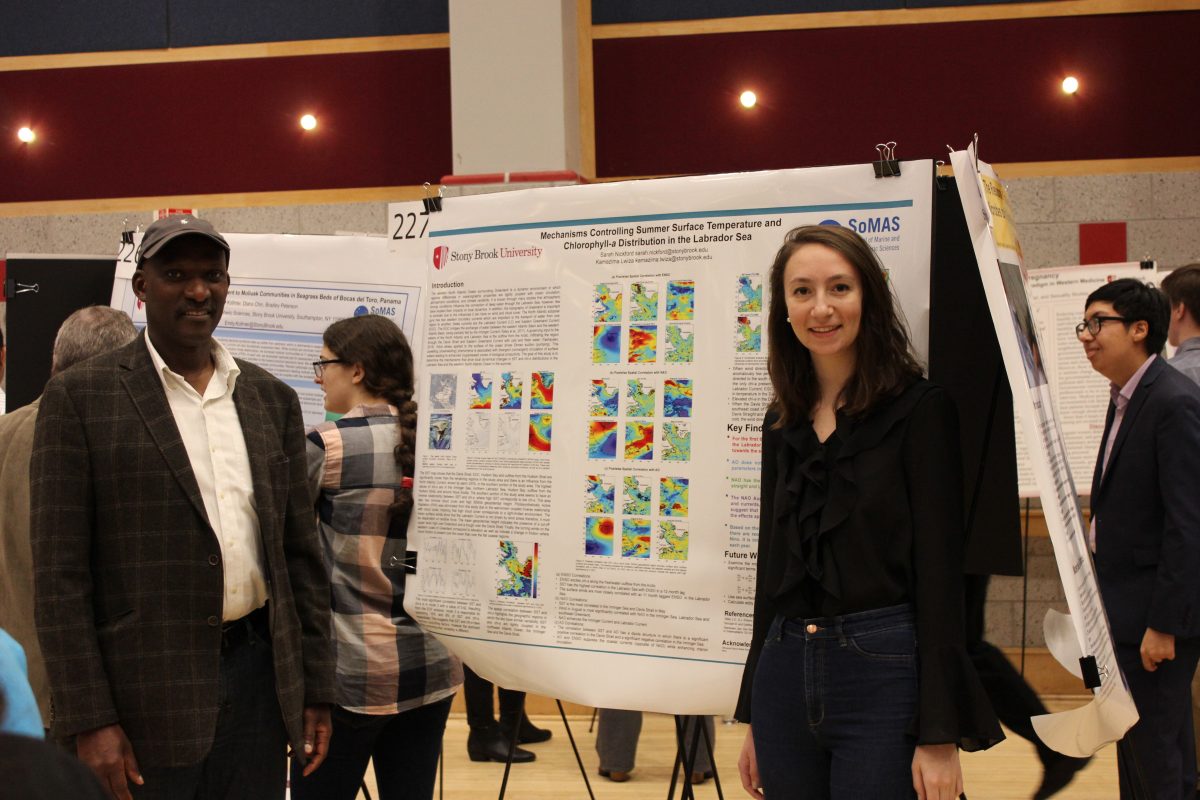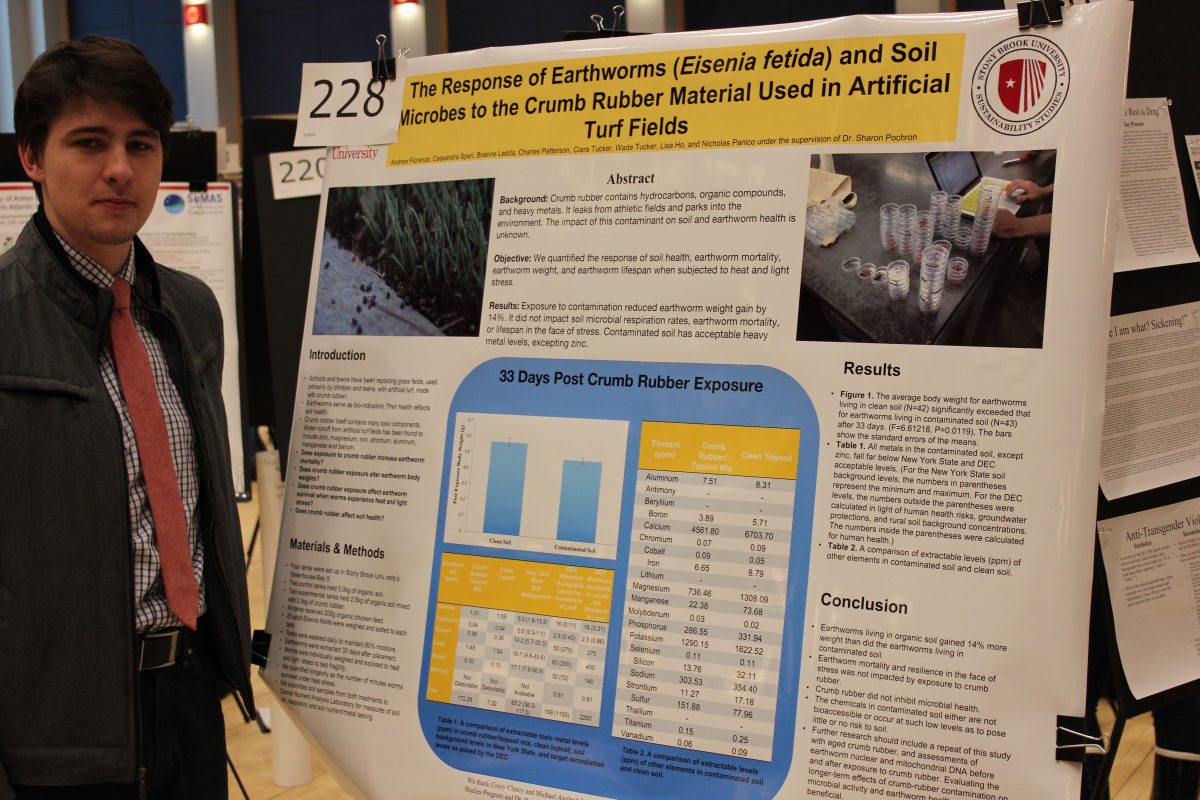The UNDERGRADUATE RESEARCH & CREATIVE ACTIVITIES (URECA) program, founded in 1987, awards research funding and travel grants to undergraduates, and is a central point of contact for students and faculty engaged in research and creative endeavors. URECA helps bring together students and research mentors, hosts annual events to showcase student work, and publishes an annual collection of undergraduate abstracts. Check our URECA website for “Researcher of the Month” features. URECA is a program within the Office of the Provost/Division of Undergraduate Education and is funded in part by the Simons Foundation.
Every year, students submit an abstract for the poster symposium. The SoMAS students who presented posters at the URECA Celebration are listed below, with their poster title and mentor.
218 Michelle Barbosa
Enhanced Susceptibility to Microbial Infections in Bivalve Larvae and Juveniles Exposed to Acidified Seawater
Bassem Allam, SoMAS
A major stressor that has gained significant importance in the last few decades is a reduction in seawater pH resulting from elevated anthropogenic CO 2 emissions in the atmosphere. Among marine organisms, shelled mollusks and most specifically bivalves are considered very sensitive to the effects of ocean acidification as acidified conditions affect shell deposition. Acclimation of bivalves to stressful environments with low pH could result in significant costs at the expense of growth or immune functions. This study was designed to assess the physiological cost of resilience to acidification in the eastern oyster Crassostrea virginica and the hard clam Mercenaria mercenaria. Specifically, we evaluated the effect of acidification on immunity and resistance of bivalve larval and juvenile stages to major microbial pathogens. Wild adult clams and oysters were separately spawned under normal conditions (400ppm) and resultant larvae were cultured under normal (400ppm) or high (1000ppm) pCO 2 conditions. Larvae (2 days old) and post-sets (28 days) grown under each condition were exposed to prominent bacterial pathogens of bivalves (Vibrio coralliilyticus, V. alginolyticus, and Listonella anguillarum) in two different experimental designs. In one design, CO 2 was bubbled directly into the experimental containers to maintain a stable pH. In the second design, no CO 2 was bubbled in which allowed pH to fluctuate and equilibrate between both treatments. In both designs, organisms were held at the same pH conditions under which they were grown. Results of both designs showed that larval bivalves exposed to higher pCO 2 conditions displayed significantly higher mortality rates following bacterial challenge than bivalves exposed to normal conditions. The study is ongoing and results from exposures of older bivalves will be presented. These findings improve our understanding of how simultaneous acidification and pathogen stress affects larval and juvenile shellfish and provide a more comprehensive view of the potential impacts of ocean acidification on shellfish resources.
This work is supported by funding through NOAA’s Northeast Sea Grant College Consortium in partnership with NOAA Ocean Acidification Program.
219 Nicole Casamassina
Analysis of Geographic Vulnerability of Areas Impacted by Hurricanes and Tropical Storms During the 2012 North Atlantic Hurricane Season Using GIS
Sung-Gheel Jang, SoMAS, Geospatial Center
The 2012 North Atlantic Hurricane Season was one of the busiest hurricane seasons on record. However, no major hurricanes made landfall to the United States. The cyclones that did make landfall, Tropical Storms Beryl and Debby, Hurricane Isaac, and Post-Tropical Storm Sandy, had significant impact on society and geography in many areas of the country. The use of a Geographic Information System (GIS) to show vulnerability can help emergency decision makers for the public by providing maps of potential coastal flooding, storm surge, and the number of people affected by severe weather events. In addition, these maps can be used in future natural disasters as a reference.
For this project, Esri ArcGIS Version 10.4.1 was used to evaluate geographic vulnerability of the counties impacted by the storms previously listed. An assessment of storm surge using land cover shows which areas were most impacted by coastal flooding. Data was used from the National Oceanic and Atmospheric Administration, the Federal Emergency Management Agency, the United States Census Bureau, Esri, and the United States Geological Survey.
Using a geospatial analysis, one would find that the effects of storm surge is greater toward the shoreline, rather than inland, and damage to infrastructure is greatest in areas of coastal flooding. Using these maps and data, people living in counties vulnerable to being impacted by tropical cyclones can better assess their risk using visual aids and government officials can create better safety and evacuation plans for when these events occur.
220 Mahin Choudhury Amrit Dhillon Serafina Margono Alex Mardon Mateo Mezic Feisal Sahebzada Nawin Sahebzada Roman Sahebzada Tayeb Sahebzada Rajwinder Singh Agatha Sleboda Akhil Saini Shabir Zahir
Can Roundup Ready Soybeans Translocate Enough Glyphosate into the Soil to Harm Non-Target Organism?
Sharon Pochron, SoMAS Sustainability Studies
Glyphosate accounts for over 80 percent of total herbicide use in the United States with over 128 million pounds sprayed annually. Farmers minimize waste by focusing their application on plant leaves and avoiding the soil. However, plants are known to translocate glyphosate beneath the soil surface, and the glyphosate can contact non-target organisms, including earthworms. Using genetically modified Roundup Ready soybeans, we examined the plants’ ability to carry levels of glyphosate dangerous to earthworms into the soil. We used two treatments. Treatment one contained Roundup Ready seeds without Roundup. Treatment two contained Roundup Ready with 0.2 ml of Roundup applied at the first trifoliate stage. Two weeks later we measured earthworm mortality, body weight, and survivorship under heat and light stress. We found that mortality remained unaffected across both treatments. The direct application of Roundup affected worm body weight and survival in the face of stress significantly. This implies that by minimizing glyphosate applications, farmers can reduce the ecological effects of glyphosate on non-target
221 Mahin Choudhury Amrit Dhillon Brett Keeler Serafina Margono Mateo Mezic Clayton Salamon Rajwinder Singh Agatha Sleboda
The Effect of a Plant-Translocated Herbicide on Earthworm Health
Sharon Pochron SoMAS Sustainability Studies
This work was supported with funding from Dr. Barry S. Coller.
Sustainability Studies Earthworm Ecotoxicology Lab The US annually sprays 130 million pounds of glyphosate-based herbicides such as Roundup. Farmers attempt to minimize their use of glyphosate by directly injecting the leaves of their crops, but plants are known to translocate glyphosate beneath the soil surface. The effects of plant-translocated glyphosate on earthworms and microorganisms remain unstudied. We tested the translocative properties of conventional soybean plants by using three treatment groups. The control contained no soybeans or Roundup. We sprayed Roundup on Group A during the first trifoliate stage, and we applied Roundup directly on the soil in Group B, which contained no soybean seed. Fourteen days later we measured earthworm mortality, body weight, and survivorship through heat stress. We found that mortality did not differ amongst the three groups. Worms with higher body weight lived longer under heat stress, but treatment type did not significantly affect body weight. Group A exhibited higher survivorship in the face of stress compared to Group B.
222 Mahin Choudhury Rhiannon Gomez Sojjad Hussaini Kyra Illuzzi Michael Mann Mateo Mezic Jaqueline Nikakis Clara Tucker
Factors Affecting Earthworm Sensitivity to a Popular Glyphosate-Based Herbicide
Sharon Pochron, SoMAS Sustainability Studies
Many farmers use glyphosate-based herbicides such as Roundup to increase harvest yield. These herbicides affect non-target organism, including red wiggler earthworms, Eisenia fetida, an organism designated by the EU, OECD, ISO and FAO as an indicator species. Many researchers have analyzed the effects of Roundup and glyphosate on earthworm health, finding inconsistent results. Some studies show that glyphosate has a negative effect, others find no effect, and still others find a positive effect. We've found the same sort of inconsistencies in our own lab. This project aimed to determine which factor might drive earthworm sensitivity to Roundup. Taking cues from the literature and our own work, we examined the effect of soil temperature, initial earthworm size, and the interaction between the two on final earthworm weight after a month of exposure to contamination. We also examined the effect of those variables on earthworm survival in a stressful environment. We used eight tanks to establish a 2 x 3 factorial design using initial worm size, soil temperature, and Roundup contamination as the three factors. After 28 days of exposure, we recorded earthworm body weight (g) and length of survivorship under stress (min). We found that both initial body size and soil temperature affected earthworm sensitivity to Roundup. Large worms grown in hot soil responded to Roundup contamination by growing significantly larger. Regardless of initial body size, earthworms living in unheated soil lived significantly shorter in the face of stress, with Roundup-exposed worms surviving for the shortest number of minutes overall. This study shows that earthworm sensitivity to Roundup varies with factors such as initial body size and soil temperature. This may explain the variation in the published literature, where neither factor is generally reported or controlled.
223 Mahin Choudhury Amrit Dhillon Mateo Mezic Nawin Sahebzada Akhil Saini Rajwinder Singh Agatha Sleboda Clara Tucker
The Short-Term Effect of Fertilizer and Roundup on Earthworm Body Weight, Fragility, and Neurological Function
Sharon Pochron, SoMAS Sustainability Studies
Mahin Choudhury completed this research in partial fulfillment of his Honor’s Project.
The US applies 130 million pounds of herbicides and 20 million tons of fertilizer to the soil annually. The interaction between these two chemicals and how it impacts Eisenia fetida, a bioindicator of soil health, remains unstudied. We tested the short-term effects of fertilizer and Roundup on earthworm body weight, fragility, and neurological function with four treatment groups: a control, a group that received only fertilizer, a group that received only Roundup, and a group that received fertilizer and Roundup. After 28 days, we extracted five worms from each treatment to test the medial giant fiber activity for action potential propagation velocity. We extracted the remaining worms to look for differences in average mortality, body weight, and survivorship in the face of heat and light stress. We found that neither mortality nor body weight differed significantly across treatments. Earthworms exposed to both fertilizer and Roundup together survived for significantly fewer minutes than worms exposed to either contaminant alone. The treatment group with both fertilizer and Roundup had slower action potential propagation speed than the other treatments.
224 Andrew Clay Rebecca Glayzer Harrison Watters
Human and Animal Traffic through Ashley Schiff Park Preserve on Stony Brook University Campus
Sharon Pochron, SoMAS Sustainability Studies
Continuing ongoing research, this study was conducted to estimate the daily amount of human and animal traffic through the Ashley Schiff Park Preserve on Stony Brook University campus. Utilizing four Simon’s Whitetail motion-activated cameras with infrared night-vision, we collected time-stamped pictures capturing anything that entered the park at the four hiking trail entrances. At these locations, human entrance into the park was recorded in regard to group size and activity (walking, biking, running). Two additional cameras were set up deeper into the woods to collect more pictures of Whitetail Deer (Odocoileus virginianus) after past results predicted the park could be a refuge for deer populations. Increased park usage was found to occur during the spring and fall semesters, and a decline in use during the campus winter and summer intersessions. This study into the patterns and values of visitors into the park preserve may serve well as a reference for park management and future studies.
225 Sarah Habashy Sajjad Hussaini Kyra Illuzzi Jennifer Maldonado Michael Mann Alex Mardon Michael Moawad Marina Nasr Jackie Nikakis Justin Roseman Akhil Saini Daniella Sallangos Mobina Talukder Katherine Tsui
Sublethal Effects of a Popular Herbicide (Roundup) on Earthworms (Eisenia fetida)
Sharon Pochron, SoMAS Sustainability Studies
Glyphosate was first introduced as an herbicide product to farmers in 1974. Glyphosate is the active ingredient in the herbicide Round Up, While the lethality of Roundup (RU) on earthworms has been examined, its sublethal effects are not well understood. We studied the effect of a particular chemical formulation, Ready Roundup, on earthworm health, specifically earthworm body weight and survivorship under stressful conditions (heat stress). We set up eight tanks containing 30 earthworms and 4.5 kilos of outdoor soil in each tank. We contaminated four tanks with 6mL of Roundup Ready-To- Use solution and left four tanks untreated. After 35 days of exposure, we recorded earthworm body weight and placed each worm into its own Petri dish. We then placed the Petri dishes in a heated (90°F) and well lit environment. The worms were monitored at 5-minute intervals and the time of deaths were recorded in order to quantify survivorship at the completion of the study. We found that average weight of worms exposed to RU showed a significant decrease in average body weight. After exposure to heat stress, the time of deaths between both groups did not differ. When exposed to RU, Eisenia fetida display evidence for some predicted sublethal effects, but it remains challenging to project our findings more generally to other common worm species.
226 Emily Kollmer
The Relationship of Sediment Carbonate Content to Mollusk Communities in Seagrass Beds of Bocas del Toro, Panama
Bradley Peterson SoMAS
Lucinid clams can form a symbiotic relationship with seagrasses: lucinids and their sulfur-oxidizing bacterial symbionts take up sulfide from sediment, which is detrimental to seagrasses in high concentrations; the seagrasses provide lucinids with oxygen and sulfide for their symbionts as well as physical protection from predators. Lucinids can also facultatively suspension feed. While lucinids are dominant members of seagrass communities worldwide, the relationships of lucinids to environmental conditions and to other seagrass infauna are not well characterized. To explore these relationships, we surveyed mollusk communities at 11 seagrass sites in Bahía Almirante, Bocas del Toro, Panama, supported by funding from the National Science Foundation and the Smithsonian Tropical Research Institute (STRI). At each site, we excavated replicate pits for assessment of the local mollusk assemblage. Live and subfossil lucinids were identified and enumerated, and representative examples of all other subfossil bivalve and gastropod shells were identified to the lowest practical taxonomic level. We also analyzed replicate sediment cores for percent carbonate content as a proxy for sulfide availability. As we predicted, live and/or subfossil lucinids were found at all sites, along with diverse mollusk communities. Percent carbonate content of sediment was not clearly related to the diversity of lucinid or overall mollusk communities. However, total abundance of lucinids tended to increase with percent carbonate content while the percentage of suspension feeding mollusk species decreased. This supports the idea that lucinids may have a competitive advantage over other suspension feeders in high-carbonate/low- iron sediments, where high sulfide availability in sediment may be coupled with low availability of suspended particles in the water column.
227 Sarah Nickford
Mechanhisms Controlling Surface Temperature and Chlorophyll Distribution in the Labrador Sea
Kamazima Lwiza, SoMAS
The goal of this project was to determine the relationship between characteristics of the North Atlantic Ocean, Labrador Sea and Arctic Ocean through the Davis Strait by analyzing the interannual variability of physical parameters. This study analyzed anomalies of sea surface temperature (SST), chlorophyll-a, cloud cover, surface winds, 500mb geopotential height, and Photosynthetically Active Radiation (PAR). Composite analysis was applied on monthly data obtained from satellites (MODIS-Aqua, SeaWiFS, NOAA) and reanalysis data (CFSR) to examine the spatial fluctuations in anomalies and attempt to characterize them based on the behavior of other selected parameters for the month of August from 1997-2016. Also, spatial and temporal patterns were analyzed by Empirical Orthogonal Function (EOF) analysis in order to obtain a thorough understanding of the changing patterns with time. The results of the EOF produced principle components which were used to establish relationships the temporal components of variability with indices of climatic patterns, such as the North Atlantic Oscillation (NAO), El Nino- Southern Oscillation (ENSO), and Arctic Oscillation (AO). Mode 1 of summertime SST seems to be driven by ENSO (correlation r=-0.5) and NAO (r=-0.6). Mode 2 seems to be dominated by AO (correlation r=0.5). The results of the composite analysis exhibit a strong relationship between anomalously warm SST and anomalously high chlorophyll off the southeast coast of Greenland in 2003, 2010, and 2016. Anomalous warming or cooling in the Davis Strait can be attributed to a buttressing effect by zonal wind stress. The results of the EOF analysis show climatic teleconnections with Greenland SST. Also the results of composite analysis highlight the importance of local dynamics.
228 Clara Tucker Charles Patterson Nick Panico
The Response of Earthworms (Eisenia fetida) and Soil Microbes to the Crumb Rubber Material Used in Artificial Turf Fields
Sharon Pochron, SoMAS
This paper has been published in Chemosphere. Charlie Patterson and Clara Tucker are in the Honors College. Nick Panico is a University Scholar.
Municipalities have been replacing grass fields with artificial turf, which uses crumb rubber infill made from recycled tires. Crumb rubber contains hydrocarbons, organic compounds, and heavy metals. Water runoff from crumb rubber fields contains heavy metals. These components can damage the environment. We contaminated topsoil with new crumb rubber and measured its impact on earthworms and soil microbes. Specifically, we compared soil microbe activity and earthworm health, survivorship, and longevity in heat and light stress under two soil regimes: clean topsoil and clean topsoil contaminated with crumb rubber. We then characterized levels of metals, nutrients, and micronutrients of both soil treatments and compared those to published New York soil background levels and to levels set by the New York State Department of Environmental Conservation (DEC) as remediation goals. We found that: 1) contaminated soil did not inhibit microbial respiration rates, 2) earthworm survivorship was not impacted by exposure to contaminated soil, 3) earthworms' ability to cope with heat and light stress remained unchanged after living in contaminated soil, but 4) earthworms living in contaminated soil gained 14% less body weight than did earthworms living in uncontaminated soil. We also found that, with the exception of zinc, heavy metals in our contaminated soil did not exceed the background levels found throughout New York State or the remediation targets set by the DEC.



